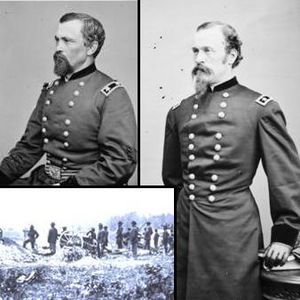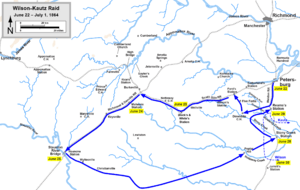Battle of Staunton River Bridge facts for kids
Quick facts for kids Battle of Staunton River Bridge |
|||||||
|---|---|---|---|---|---|---|---|
| Part of the American Civil War | |||||||
 Clockwise from upper left: Brigadier General August V. Kautz, Brigadier General James H. Wilson, Confederate artillery firing across the river |
|||||||
|
|||||||
| Belligerents | |||||||
| Commanders and leaders | |||||||
| James H. Wilson August V. Kautz |
William Henry Fitzhugh Lee Benjamin L. Farinholt |
||||||
| Strength | |||||||
| 5,000 | 4,100 | ||||||
| Casualties and losses | |||||||
| 116 total 42 killed 44 wounded 30 missing/captured |
34 total 10 killed 24 wounded |
||||||
The Battle of Staunton River Bridge was a fight during the American Civil War. It happened on June 25, 1864. This battle was part of a larger mission called the Wilson–Kautz Raid. Union and Confederate soldiers fought near the Staunton River Bridge. This bridge crossed the Staunton River in Halifax County, Virginia and Charlotte County, Virginia.
Contents
Why This Battle Happened
During June 1864, Confederate General Robert E. Lee was defending Petersburg, Virginia. Union forces, led by Ulysses S. Grant, were trying to capture Petersburg. This was known as the Siege of Petersburg.
The Confederate army needed supplies like food and weapons. These supplies came by train from the south and west. Grant knew that if he could stop these supplies, Lee's army would have to leave Petersburg.
So, Grant sent Union cavalry to destroy the train tracks. On June 22, about 5,000 Union cavalry soldiers were sent. They also had 16 artillery cannons. These troops were led by James H. Wilson and August V. Kautz. Their mission was to cut off the Confederate supply lines. For three days, they destroyed about 60 miles (97 km) of railway. Confederate cavalry, led by W.H.F. "Rooney" Lee, chased them.
The Battle Begins
The Staunton River Bridge was very important. It carried the Richmond and Danville Railroad over the Staunton River. This railroad was a key supply route for the Confederate army in Petersburg.
Captain Benjamin L. Farinholt led the Confederate defenders. He had 296 reservists guarding the bridge. On June 23, he learned that Union cavalry was coming. He quickly sent messages to nearby towns. He asked for more soldiers to help defend the bridge.
By the morning of the battle, 642 more fighters arrived. About 150 were regular soldiers. The rest were volunteers. This brought his total force to 938 men.
Clever Tricks to Fool the Enemy
Captain Farinholt used a clever trick. He made a train run back and forth along the tracks. This made it look like he was getting many more soldiers.
A local woman, Mrs. Nancy Mcphail, also helped. She hosted wounded Union soldiers. She told the Union forces that 10,000 Confederate soldiers were waiting at the bridge. In reality, there were only 938 men. These tricks made the Union forces think the bridge was much stronger.
Defending the Bridge
Farinholt had two earthwork forts on the south side of the river. He placed his 6 cannons there. Four cannons were on the east side of the tracks. Two were on the west side. He also built hidden trenches for his riflemen. These trenches were between the forts and the bridge.
At 3:45 p.m., the Union forces arrived on the north side of the river. They were about a mile from the main fort. Farinholt's first cannon shots missed.
Union General Kautz had his cavalry get off their horses. They attacked the bridge from both the east and west sides. Colonel Robert M. West led the attack from the west. He tried to quickly capture the bridge and burn it. But his attack was stopped.
The Union soldiers reached a ditch about 150 yards (137 m) from the bridge. From there, they tried to charge the bridge four times. Each time, they were pushed back. The hidden Confederate trenches caused many Union casualties.
Confederate Reinforcements Arrive
Around sunset, "Rooney" Lee arrived with his Confederate cavalry. These were the soldiers who had been chasing the Union raiders. Lee attacked the Union forces from behind. This forced Union General Wilson to retreat by midnight.
The next morning, Farinholt's soldiers moved forward. They found 8 Union prisoners and buried 42 Union dead. The Union lost 42 killed, 44 wounded, and 30 missing or captured. The Confederates had 10 killed and 24 wounded.
What Happened Next
The defense of the Staunton River Bridge was a success for the Confederates. It kept the Richmond & Danville railroad supply line open. This line was very important for the Confederate army in Petersburg.
However, the Confederates could not hold Petersburg forever. In April 1865, their supply lines were finally cut. General Lee was forced to leave Petersburg.
Today, part of the battle area is a park. It is called Staunton River Battlefield State Park. The old Confederate defenses are listed as historic places.


